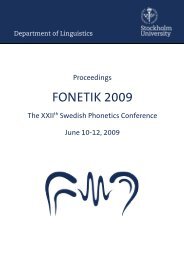The Double Passive in Swedish - Institutionen för lingvistik ...
The Double Passive in Swedish - Institutionen för lingvistik ...
The Double Passive in Swedish - Institutionen för lingvistik ...
You also want an ePaper? Increase the reach of your titles
YUMPU automatically turns print PDFs into web optimized ePapers that Google loves.
(26) a) John hoppas kyssas av Jane.<br />
3SG hope:DEP kiss:DEP by 3SG.<br />
‘John hopes to be kissed by Jane’.<br />
b) *Jane hoppa-r kyssa John.<br />
3SG jump-PRS kiss:INF 3SG.<br />
‘Jane jumps to kiss John.<br />
Reflexives and reciprocals are def<strong>in</strong>ed as deponents <strong>in</strong> SAG 2 (1999:556), consider (27) and (28).<br />
(27) Kartellen hoppas enas om att öka oljeproduktionen.<br />
Cartel:the hope:DEP unite:RECP about to:COMP <strong>in</strong>crease oil production:the.<br />
‘<strong>The</strong> cartel is hop<strong>in</strong>g to unanimously agree to <strong>in</strong>crease the oil production.’<br />
(28) Vi hoppas samlas kr<strong>in</strong>g brasan.<br />
2sg hope:DEP gather:REFL around fire:the.<br />
‘We hope that we’ll be able to gather around the fire place.’<br />
In SAG 2 (1999:554-557), the most frequent deponents are listed and def<strong>in</strong>ed as non-passive.<br />
2.7.3 Parasitic mark<strong>in</strong>g<br />
Some rais<strong>in</strong>g verbs <strong>in</strong> <strong>Swedish</strong> appear to be passivized when they are not. E.g. a rais<strong>in</strong>g verb<br />
(functional verb) might be mistaken for a passivized equi verb (lexical verb) due to an active rais<strong>in</strong>g<br />
verb’s given -s form. In SAG 3 (1999:575), it is mentioned that some language-users prefer to use the<br />
-s form on an active matrix verb like ‘behöva’ 11 <strong>in</strong> a passive clause, as <strong>in</strong> (29):<br />
(29) Bilen (?)behövs laga-s.<br />
Car:the need:PRS repair:INF-PASS<br />
‘<strong>The</strong> car needs to be repaired.’<br />
In contrast, grammarians recommend the use of a present tence “-s less” form, accord<strong>in</strong>g to SAG 3<br />
(1999:575), as <strong>in</strong> (30):<br />
(30) Bilen behöv-er laga-s.<br />
Car:the need-PRS repair:INF-PASS<br />
‘<strong>The</strong> car needs to be repaired.’<br />
It is suggested that the use of -s form on (rais<strong>in</strong>g) matrix verbs is a case of phonological expression<br />
(spoken <strong>Swedish</strong>), rather than a syntactic feature (Wiklund, 2001:199). This proposed phonological<br />
phenomenon is often referred to <strong>in</strong> the literature as parasitic mark<strong>in</strong>g 12 . In simple terms, the s- form on<br />
11 In SAG (1999) ‘behöva’ (‘need’) is partly described as possess<strong>in</strong>g several ma<strong>in</strong> verb-features, whilst<br />
Sundman (1983:323) classifies ’behöva’ as be<strong>in</strong>g considered an auxiliary verb (AUX). <strong>The</strong> verb ‘behöva’<br />
is a case of a cont<strong>in</strong>uum – i.e. the function of the verb might vary depend<strong>in</strong>g on the context.<br />
12 Also refered to <strong>in</strong> the literature as copy<strong>in</strong>g and multiple exponance (Sells, 2004:191).<br />
20

















